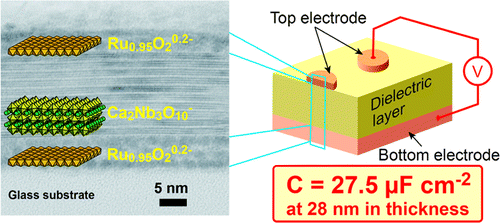Advance in energy storage could speed up development of next-gen electronics

Electronics are getting smaller all the time, but there's a limit to how tiny they can get with today's materials. Researchers now say, however, that they have developed a way to shrink capacitors—key components that store energy—even further, which could accelerate the development of more compact, high-performance next-gen devices. The study appears in the journal ACS Nano.
Takayoshi Sasaki and colleagues point out that many recent improvements have already downsized capacitors significantly. But current technology has almost reached its limit in terms of materials and processing, which in turn limits the performance that manufacturers can achieve. In response, researchers have gone to the nanoscale, but "nanocapacitors" are not easy to make.
They require harsh, difficult-to-use methods and even then, they may not work that well. So Sasaki's team developed an easier approach, and they use it to make high-performance "ultrathin" capacitors.
The researchers found that they could use gentle techniques and mild conditions to create a sandwich consisting of layers of two different types of oxide nanosheets to produce an ultrathin capacitor. In addition, the new capacitor has a capacitance density about 2,000 times higher than that of commercially available products. They say that, in the future, the ultrathin capacitors could be used in printed circuit boards and in memory storage devices, for example.
More information: "All-Nanosheet Ultrathin Capacitors Assembled Layer-by-Layer via Solution-Based Processes" ACS Nano, Article ASAP. DOI: 10.1021/nn406367p
Abstract
All-nanosheet ultrathin capacitors of Ru0.95O20.2–/Ca2Nb3O10–/Ru0.95O20.2– were successfully assembled through facile room-temperature solution-based processes. As a bottom electrode, conductive Ru0.95O20.2– nanosheets were first assembled on a quartz glass substrate through a sequential adsorption process with polycations. On top of the Ru0.95O20.2– nanosheet film, Ca2Nb3O10– nanosheets were deposited by the Langmuir–Blodgett technique to serve as a dielectric layer. Deposition parameters were optimized for each process to construct a densely packed multilayer structure. The multilayer buildup process was monitored by various characterizations such as atomic force microscopy (AFM), ultraviolet–visible absorption spectra, and X-ray diffraction data, which provided compelling evidence for regular growth of Ru0.95O20.2– and Ca2Nb3O10– nanosheet films with the designed multilayer structures. Finally, an array of circular films (50 μm ) of Ru0.95O20.2– nanosheets was fabricated as top electrodes on the as-deposited nanosheet films by combining the standard photolithography and sequential adsorption processes. Microscopic observations by AFM and cross-sectional transmission electron microscopy, as well as nanoscopic elemental analysis, visualized the sandwich metal–insulator–metal structure of Ru0.95O20.2–/Ca2Nb3O10–/Ru0.95O20.2– with a total thickness less than 30 nm. Electrical measurements indicate that the system really works as an ultrathin capacitor, achieving a capacitance density of 27.5 μF cm–2, which is far superior to currently available commercial capacitor devices. This work demonstrates the great potential of functional oxide nanosheets as components for nanoelectronics, thus contributing to the development of next-generation high-performance electronic devices.
Journal information: ACS Nano
Provided by American Chemical Society




















